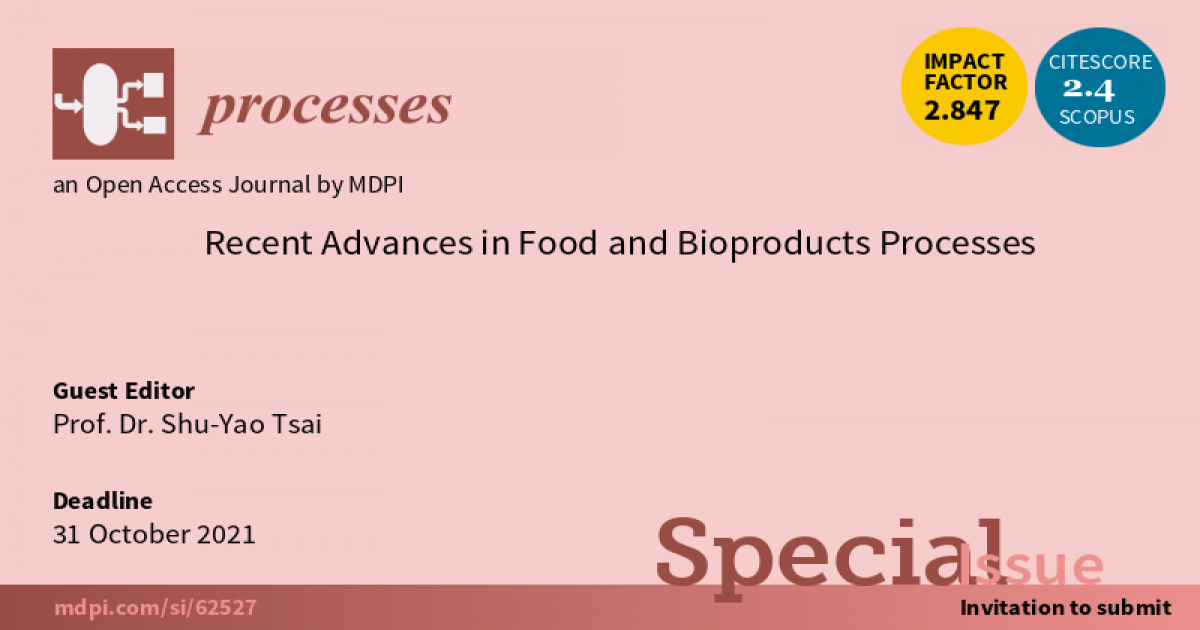- 2.8Impact Factor
- 5.5CiteScore
- 16 daysTime to First Decision
Recent Advances in Food and Bioproducts Processes
This special issue belongs to the section “Food Process Engineering“.
Special Issue Information
Dear Colleagues,
In the development of health-promoting food ingredients and functional food processing, the focus of laboratory studies is primarily on edible and medicinal mushrooms, food processing and preservation technology, functional food ingredients processing, and bioproducts processing. Functional food ingredients can be obtained from various bioresources, such as plants, animals, microorganisms, and marine sources, as well as their by-products. Contributions that deal with new developments in processes and that can be given quantitative expression are encouraged.
This Special Issue of Processes will present a collection of research articles and reviews related to the development of advances in natural product food processes. According to the desired products, several production steps are required in order to produce a food product from raw ingredients, to change the physical and chemical appearance of the product, to ensure food safety, to ensure a consistent quality, and to improve shelf-life, etc.
Prof. Dr. Shu-Yao Tsai
Guest Editor
Manuscript Submission Information
Manuscripts should be submitted online at www.mdpi.com by registering and logging in to this website. Once you are registered, click here to go to the submission form. Manuscripts can be submitted until the deadline. All submissions that pass pre-check are peer-reviewed. Accepted papers will be published continuously in the journal (as soon as accepted) and will be listed together on the special issue website. Research articles, review articles as well as short communications are invited. For planned papers, a title and short abstract (about 250 words) can be sent to the Editorial Office for assessment.
Submitted manuscripts should not have been published previously, nor be under consideration for publication elsewhere (except conference proceedings papers). All manuscripts are thoroughly refereed through a single-blind peer-review process. A guide for authors and other relevant information for submission of manuscripts is available on the Instructions for Authors page. Processes is an international peer-reviewed open access monthly journal published by MDPI.
Please visit the Instructions for Authors page before submitting a manuscript. The Article Processing Charge (APC) for publication in this open access journal is 2400 CHF (Swiss Francs). Submitted papers should be well formatted and use good English. Authors may use MDPI's English editing service prior to publication or during author revisions.
Keywords
- novel food processes
- natural product
- food processing and technology
- medicinal benefits processing
- non-thermal processes
- by-product processing
- functional food ingredients
- fermentation in food processing
- microencapsulation technology
- minimal processing techniques

Benefits of Publishing in a Special Issue
- Ease of navigation: Grouping papers by topic helps scholars navigate broad scope journals more efficiently.
- Greater discoverability: Special Issues support the reach and impact of scientific research. Articles in Special Issues are more discoverable and cited more frequently.
- Expansion of research network: Special Issues facilitate connections among authors, fostering scientific collaborations.
- External promotion: Articles in Special Issues are often promoted through the journal's social media, increasing their visibility.
- e-Book format: Special Issues with more than 10 articles can be published as dedicated e-books, ensuring wide and rapid dissemination.

